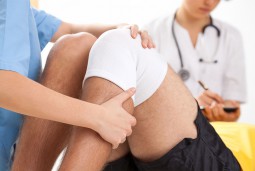When you injure knee cartilage, this is sometimes known as an osteochondral defect. This refers to damage that occurs in your knee cartilage and the underlying bone, such as a total loss of cartilage, cartilage that develops a rough surface or fragments of cartilage and bone that interfere with your ability to move. If you have severe symptoms that restrict your activities and they’re not responding to other forms of treatment, your doctor might recommend surgery.
What Are the Symptoms of Knee Cartilage Injuries?
Osteochondral defects in your knee typically cause pain and stiffness. Over time, these symptoms can become severe enough to make it difficult for you to perform daily activities. These injuries are not usually able to heal on their own. When left untreated, the damaged cartilage can wear away and leave the ends of the bones in your knee joint rubbing against one another. This can cause persistent pain and lead to the development of deformities in your knee joint.
What Causes These Injuries?
You can develop osteochondral defects if you participate in sports, especially contact sports that involve rough play, such as football. Basketball, soccer and other sports that involve making sudden changes in direction while you’re moving can also increase your risk of injuring your knee cartilage. In some cases, these defects develop when you suffer another injury, such as a torn knee ligament or a tear in your meniscus. Knee cartilage injuries can also occur due to overuse as your cartilage wears away gradually.
How Are They Treated?
The treatment for osteochondral defects depends on whether they’re minor or severe. Treatment for minor damage typically involves limiting activities that put you at risk of making your injury worse. You might also have to wear a cast to keep your knee still until it heals. If your injury is worse, you might have arthroscopy done to assess the damage and remove the affected cartilage and bone. The damaged cartilage taken out is replaced by new cartilage in a procedure known as cartilage transfer.
Is Surgery Right for You?
Your doctor might recommend surgery if pain and other symptoms from knee cartilage injuries don’t improve with nonsurgical treatment. Surgery might also be an option if you have severe symptoms that prevent you from going about your usual activities or make it difficult for you to perform simple movements. Your doctor will conduct a physical exam and do testing to determine whether or not you have osteochondral defects and how severe they are. These tests include taking a sample of fluid from the affected area to look for fatty tissue or blood, which indicates damage. Your doctor might also take X-rays and other imaging tests, such as an MRI, to evaluate your condition. Keep in mind that cartilage transfer procedures are typically more successful for young adults or those who have a single injury rather than multiple ones in this part of the knee.
What Types of Surgical Procedures Are Available?
There are several ways to transfer healthy cartilage to the knee joint in order to replace damaged cartilage. These include the following:
- Microfracture: This involves making several small holes in the surface of your knee joint to encourage new blood flow. This helps promote the growth of healthy cartilage in the affected area. Microfracture is a minimally invasive procedure that can be done with arthroscopy, which involves making small incisions and using small instruments and a camera.
- Drilling: Drilling is similar to microfracture, but holes in the underlying bone are done with a drill. This procedure also promotes healthy cartilage growth.
- Abrasion Arthroplasty: This is a minimally invasive procedure that involves making several holes in the affected area with high-speed burrs. These burrs help remove damaged cartilage.
- Autologous Chondrocyte Implantation: This procedure involves growing new cartilage cells from healthy cartilage tissue, then implanting them in the affected area. This requires performing open surgery, rather than minimally invasive arthroscopic surgery.
- Osteochondral Autograft Transplantation: This minimally invasive procedure involves taking healthy cartilage from another area of your knee joint and placing it in the damaged area to create a smooth surface. These autografts are usually done for smaller knee cartilage injuries.
- Osteochondral Allograft Transplantation: This is done using tissue grafts from cadavers. You might have this done if your injury is too big for an autograft.
Keep in mind that as with any surgery, there are risks for each of these procedures. These include infection, bleeding and damage to the nerves or other structures close to the surgical site.



